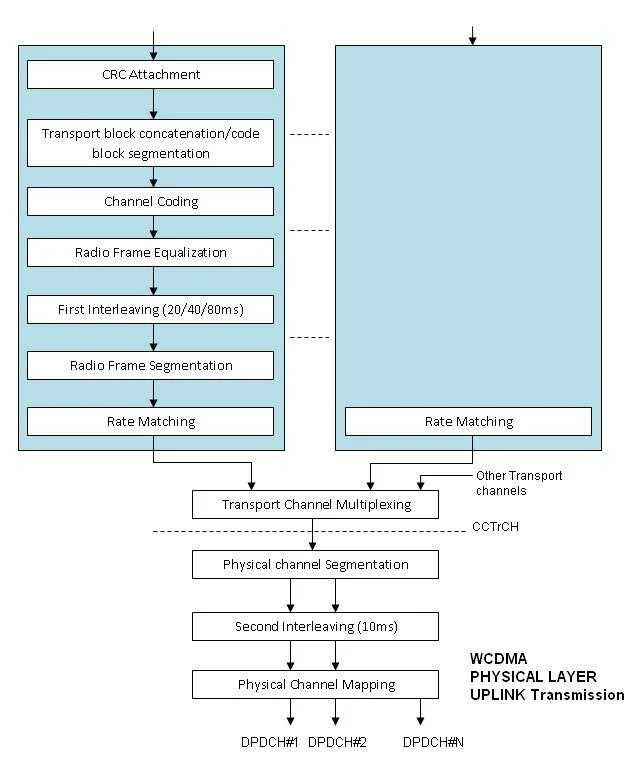WCDMA Physical Layer design(FDD)
This page of tutorial covers FDD mode WCDMA Physical layer design as per UTRA specification documents 3GPP TS 25.212. It explains both the uplink and downlink transmission modules. It also provide link to comparison with TDD physical layer version.
The physical layer provides different transport channels to carry MAC layer's logical channels.
Similarly MAC layer provides different logical channels to the RLC sublayer of layer 2 of
WCDMA protocol stack.
The logical channel is identified by type of information carried over.
The transport channel is identified by how the information is transferred over air interface.
Physical channels are defined in the Physical layer. In WCDMA Physical layer is controlled via RRC layer.
There are two duplexing modes TDD and FDD. Based on the duplex method there are two different physical layers.
In TDD mode, a physical channel is characterised by timeslot.
While in FDD mode,in the downlink a physical channel is characterised by code, frequency.
In FDD uplink, a channel is characterised by relative phase of I/Q.
The basic unit exchanged between L1 and MAC is referred as Transport block.
Following are the block diagrams of the modules used in physical layer uplink transmission and downlink transmission in the
FDD mode. WCDMA Physical layer performs following funtions:
• Macro-diversity distribution and combining including execution of soft handover operation
• Error detection of transport channels using CRC and reporting to upper layer using indication messages.
• Forward Error Correction encoding and decoding of the transport channels
• Multiplexing operation on transport channels and demultiplexing operation of
CCTrCHs (i.e. coded composite transport channels). CCTrCH is basically a combination of all the transport channels
to be multiplexed on the physical channel.
• Rate matching of coded transport channels to physical channels.
• Mapping of CCTrCHs on physical channels.
• Power weighting and combining of physical channels.
• Modulation/spreading and demodulation/despreading of the physical channels.
• Frequency and time synchronisation(i.e. chip/bit/slot/frame synchronization)
of the received frame from the NodeB.
• Radio related measurements which includes FER, signal to interference ration,Interference Power and indication of the same to upper layers.
• Inner loop power control
• RF processing to make the baseband I/Q data capable of carrying over the air and interface with
NodeB RF carriers.

Following are the modules in the uplink of WCDMA physical layer transmitter:
• CRC Attachment
• Transport Block concatenation/Code Block Segmentation
• Channel Coding
• Radio Frame Equalization
• First Interleaving
• Radio Frame Segmentation
• Rate Matching
• TrCH Multiplexing
• Physical Channel Segmentation
• Second Interleaving
• Physical Channel Mapping

Following are the modules in the downlink of WCDMA physical layer transmitter:
• CRC Attachment
• Transport Block concatenation / code block segmentation
• Channel coding
• Rate matching
• First insertion of DTX indication
• First interleaving
• Radio frame segmentation
• Transport Channel multiplexing
• Second insertion of DTX indication
• Physical channel segmentation
• Second interleaving
• Physical channel mapping
Similar posts on WCDMA (UMTS)
UMTS Tutorial UMTS channels measurements PHY layer TDD vs FDD PHY RRC States Security Cell search Bands UARFCN Frame
What is Difference between
Difference between TDD and FDD WCDMA physical layer
Difference between TDD and FDD
FDMA vs TDMA vs CDMA
CDMA vs GSM
Other Standard Physical Layers
• Wireless physical layer overview
• 11b physical layer
• 11a physical layer
• fixed wimax physical layer-OFDM
• mobile wimax physical layer-OFDMA
• 11n physical layer
• GSM Physical layer
• TD-SCDMA Physical layer
• GPRS physical layer
• LDACS1 Physical layer
• 10,40,100 Gigabit Ethernet Physical layer
• Zigbee Physical layer
• WCDMA Physical layer
• Bluetooth Physical layer
• WLAN 802.11ac Physical layer
• WLAN 802.11ad Physical layer
• LTE Physical layer
